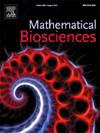Analyzing time activity curves from spatio-temporal tracer data to determine tracer transport velocity in plants
IF 1.8
4区 数学
Q2 BIOLOGY
引用次数: 0
Abstract
Non-invasive methods utilizing tracers have a great potential to investigate carbon allocation in plants. Specifically, radioactive tracers, such as , enable the monitoring of spatially localized transport processes on short time scales in living plants. Typically, such tracer transport experiments yield time activity curves (TACs) of tracer activity over time at various locations along a transport pathway. These TACs can exhibit different characteristic shapes that strongly depend on tracer transport dynamics, reflecting properties such as transport velocity, exchange with surrounding tissue, and tracer storage along the pathway. Various methods, either data-driven or model-based, exist to determine transport velocities from TACs. However, for some TAC shapes, the inferred carbon tracer velocity values can be inconsistent and greatly vary between analysis methods. In the present study, we review and evaluate different analysis methods for their suitability to reliably determine tracer transport velocities from typical TAC shapes. For this evaluation, we use both in silico generated and experimentally acquired TACs from positron emission tomography measurements on tomato, barley, and bean. We demonstrate that each of the compared methods can be suitable for specific TAC shapes while being less or not appropriate for others. In conclusion, we present a case-specific evaluation of methods as a reference for analyzing TACs from tracer transport experiments, which allows to ensure a robust and globally comparable determination of transport velocities.
分析时空示踪剂数据的时间活动曲线,确定植物体内的示踪剂迁移速度。
利用示踪剂的非侵入式方法在研究植物的碳分配方面具有巨大潜力。具体来说,放射性示踪剂(如 11C11C)可以在短时间内监测活体植物的局部空间迁移过程。通常情况下,此类示踪剂迁移实验会产生示踪剂在迁移路径上不同位置随时间变化的时间活度曲线(TAC)。这些时间活动曲线会呈现出不同的特征形状,这些形状在很大程度上取决于示踪剂的迁移动力学,反映了迁移速度、与周围组织的交换以及沿迁移途径的示踪剂储存等特性。目前有多种方法(数据驱动或基于模型)来确定 TAC 的传输速度。然而,对于某些 TAC 形状,推断出的碳示踪剂速度值可能不一致,而且不同分析方法之间差异很大。在本研究中,我们回顾并评估了不同的分析方法,以确定它们是否适合可靠地确定典型 TAC 形状的示踪剂迁移速度。在评估过程中,我们使用了从番茄、大麦和豆类的正电子发射断层扫描测量中硅学生成和实验获得的 TAC。我们证明,所比较的每种方法都适用于特定的 TAC 形状,而对其他形状则不太适用或不适用。总之,我们提出了一种针对具体情况的评估方法,作为分析示踪剂迁移实验中 TAC 的参考,从而确保对迁移速度进行稳健且具有全球可比性的测定。
本文章由计算机程序翻译,如有差异,请以英文原文为准。
求助全文
约1分钟内获得全文
求助全文
来源期刊

Mathematical Biosciences
生物-生物学
CiteScore
7.50
自引率
2.30%
发文量
67
审稿时长
18 days
期刊介绍:
Mathematical Biosciences publishes work providing new concepts or new understanding of biological systems using mathematical models, or methodological articles likely to find application to multiple biological systems. Papers are expected to present a major research finding of broad significance for the biological sciences, or mathematical biology. Mathematical Biosciences welcomes original research articles, letters, reviews and perspectives.
 求助内容:
求助内容: 应助结果提醒方式:
应助结果提醒方式:


